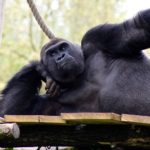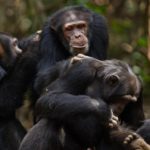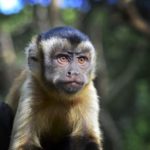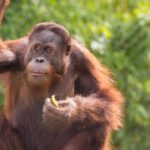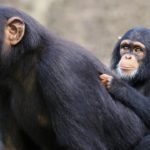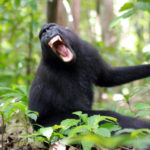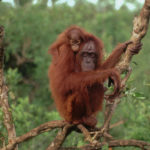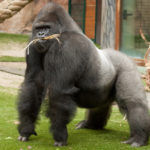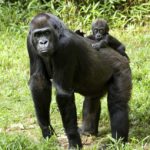Chimpanzees
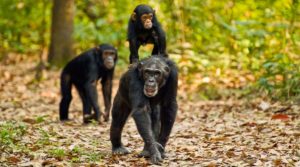 The genus of the great apes comes from Africa. It includes two species – common chimpanzee and bonobo chimpanzee. You can often hear how the first species is called without an adjective, and the second is called a dwarf chimpanzee or just a bonobo. The very name of these monkeys is borrowed from the language of the Luba tribe and in translation means “similar to man”. Chimpanzees are related to other anthropoid monkeys – orangutans and gorillas.
The genus of the great apes comes from Africa. It includes two species – common chimpanzee and bonobo chimpanzee. You can often hear how the first species is called without an adjective, and the second is called a dwarf chimpanzee or just a bonobo. The very name of these monkeys is borrowed from the language of the Luba tribe and in translation means “similar to man”. Chimpanzees are related to other anthropoid monkeys – orangutans and gorillas.
Both species of these monkeys are very similar to each other, contrary to their informal name, the dwarf chimpanzee is no less than its counterpart, just looks more slender. When looking at the chimpanzee attracts attention volumetric skull, containing the brain, which is only half the human. The powerful jaws protrude strongly forward and are armed with sharp fangs. The nose, on the contrary, is comparatively small and flat compared to the human. Also these monkeys have well developed ears and superciliary arches.
The forelimbs of a chimpanzee are almost equal in length to the posterior. On all paws, the thumb is opposed to the rest, which indicates the ability of animals to manipulate small objects. On the palms and fingers of the forelimbs there is a cutaneous pattern, it is as individual and unique as in humans, so chimpanzees can be distinguished by fingerprints. In general, these monkeys are very well developed musculature – they are superior in strength to humans, although below its growth. The body is covered with a thick, moderately long, straight hair, the palms and soles of the feet, ears and face remain bare.
Sexual dimorphism is reduced to a difference in size. The males of these monkeys weigh 55-70 kg with growth up to 1.5 m, females weigh 33-50 kg with growth up to 1.3 m. In general, the chimpanzee gene is 98.7% identical with the human. Physiologically (if you do not take into account the difference in appearance and behavior), these monkeys are no different from us, for example, they have the same blood groups as humans.
Ordinary chimpanzees live in West and Central Africa, inhabited by moist forests and dry savannahs. Bonobos inhabit Central Africa, and are found only in moist forests, and do not enter savannahs. Both species live in groups of 15-30 individuals. There is a strict hierarchy in the chimpanzee communities. Common chimpanzees are headed by a group leader, which is surrounded by a suite of males of a lower rank. As a rule, the main male tries to maintain good relations with at least a few of them, giving friends favors and sharing with them prey.
In the event of any conflicts, he can be sure that they will act on his side. For the remaining rivals, the male threatens with gestures, grins, holding them in constant fear, and, if necessary, can engage in a fight. However, not always the leader is the strongest in the herd, more often this place is occupied by the most cunning, diplomatic and adapted beast. If the leader is old or poorly copes with his duties, he can be replaced by a more worthy candidate. Females in the group are also divided into ranks, but their position does not depend on intelligence and strength, but on the dose of attention that males give them. Leading females beg for the most delicious parts of the prey from the males, they are better developed, and during the breeding season more boys are attracted.
In groups of common chimpanzees, you can observe a wide variety of behaviors. Males are usually aggressive, in extreme cases, protecting their territory, they can even kill an animal from a neighboring group, and the victim’s body is eaten with pleasure by the winners. Females during the hunt are not as active, at least not so successful, therefore they often appear on the positions of begging for food. At the same time, female individuals are more likely to show compassion: they can adopt an orphaned baby, share food with an old member of the group, sympathize with the wounded or mother who has lost the baby.
In general, ordinary chimpanzees are considered quite aggressive animals. Suffice it to say that in nature there are cases when these monkeys tried to hunt humans. In captivity, for training and experiments, only young individuals are used, since adults become dangerous to humans. As for the chimpanzees of bonobos, the structure of their groups is the same as that of ordinary chimpanzees, with the only difference being that the female leads the herd. Bonobos are not aggressive, because they have developed a special method of settling conflicts. Universal means of communication they are … sex. They are mated regardless of their age and breeding period.
